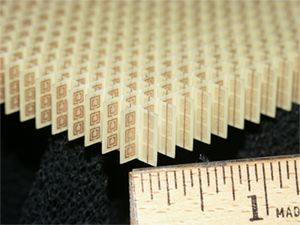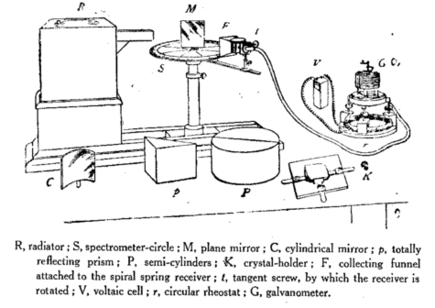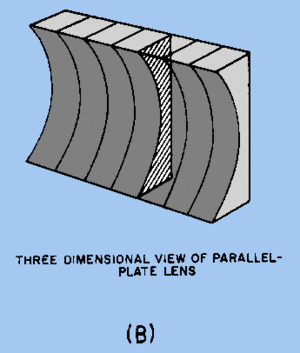تاريخ الميتاماتريال

'تاريخ المواد الميتاماتيريال يبدأ عقب تطوير العوازل الصناعية في هندسة الميكروويف لأنها وضعت بعد تاريخ الرادار في الحرب العالمية الثانية . وبالإضافة إلى ذلك، هناك استكشافات عديدة من المواد الاصطناعية لمعالجة الموجات الكهرومغناطيسية في نهاية القرن 19th. وبالتالي، فإن التاريخ يتعلق بما وارء ذلك هو في جوهره تاريخ تطوير أنواع معينة من المواد المصنعة، التي تتفاعل في تردد الراديو، الميكروويف، وفيما بعد الترددات الضوئية .[1][2]
حيث أن علم المواد قد أحرز تقدما، فقد تم استبدال الفوتونات الضوئية المادية محل الإلكترونات على إعتبار أن فوتون الناتجة من ضوء باعتبارها الناقل الأساسي للمعلومات. وبالتالي، بشرت الأبحاث المذكورة آنفا في الكريستال الضوئية و دليل على مبدأ metamaterials مع معامل إنكسار سلبى. حدث هذا أولا في نطاق الميكروويف في بداية الألفية الجديدة. وأعقب ذلك الوصول إلى دليل لمبدأ الحجب بإستخدام المواد الفوقية (بجعل الكائن محاطا بدرع يحفظه من الرؤية)، أيضا في نطاق الموجات الدقيقة، بعد ست سنوات حول.[3] ومع ذلك، فإمكانية أن عباءة إخفاء الكائنات عبر كامل الطيف الكهرومغناطيسي لا يزال بعيدا ويحتاج عقود. العديد من مشاكل الفيزياء و الهندسة مازالت تحتاج إلى حلول.
ومع ذلك، مواد الانكسار السلبي أدت إلى تطوير هوائيات المواد الفوقية و عدسة الميكروويف المواد الفوقية وفاق إن نظم هوائيات لاسلكية مصغرة التي هى أكثر كفاءة من نظيراتها التقليدية. أيضا، فإن الهوائيات للمواد الفوقية metamaterial الآن متاحة تجاريا. وفي الوقت نفسه، subwavelength التركيز مع superlens هو أيضا جزء من الأبحاث في الوقت الحاضر التى تتعلق بالمواد الفوقية.[3]
. . . . . . . . . . . . . . . . . . . . . . . . . . . . . . . . . . . . . . . . . . . . . . . . . . . . . . . . . . . . . . . . . . . . . . . . . . . . . . . . . . . . . . . . . . . . . . . . . . . . . . . . . . . . . . . . . . . . . . . . . . . . . . . . . . . . . . . . . . . . . . . . . . . . . . . . . . . . . . . . . . . . . . . .
الدراسات المبكرة للموجات

إن تاريخ المواد الفوقية يمكن أن يشتمل على نقاط مبدأية عديدة تعتمد على خصائص مثيرة للإهتمام المتعلقة مبكرا ب دراسة الموجات بدأت في عام 1904 وإستمرت من خلال أكثر من نصف الجزء الأول من القرن العشرين.هذا البحث المبكر إشتمل على العلاقة من سرعة الطور إلى سرعة المجموعة والعلاقة بين موجة ناقلات و مؤشر الناقلات.[4][5][6]
فى عام 1904 فإن إمكانية سرعة الطور السلبية مصحوبة ب مضاد التوازى (رياضيات) كانت سرعة المجموعة قد تم ملاحظتها بواسطة (كتاب هوراس لامب : ديناميكا السوائل) و (كتاب آرثر شوستر : مقدمة إلى علم البصريات). ولكن كل من الفكر العملي لتحقيق هذه الظاهرة غير ممكن. في عام 1945 ليونيد ماندلستام (أيضا "Mandel'shtam") درس المرحلة المضادة للالموازية ووتم التقدم للمجموعة بمزيد من التفاصيل. ويلاحظ أيضا أنه درس الخصائص الكهرومغناطيسية للمواد التى تتميز بخاصية الانكسار السلبى، وكذلك لأول مرة مفهوم اليد اليسرى المتوسطة. وشملت هذه الدراسات السلبية سرعة المجموعة. وذكر أن مثل هذه الظواهر تحدث في الكريستالات الشعرية. يجوز هذا يعتبر هاما لأن الميتاماتيريال هى من صنع الانسان الكريستال شعرية (هيكل).[4][5][7][8] في عام 1905 H. C Pocklington درس أيضا بعض الآثار المتعلقة بسرعة المجموعة السلبية.[9]
V.E. Pafomov (1959)، وفيما بعد عدة سنوات، وفريق البحث VM Agranovich وV.L. ذكر غينسبورغ (1966) وrepurcussions من السماحية السلبية ، و نفاذية السلبية و سرعة المجموعة، في دراستهم للبلورات و excitons.[4][5]
في عام 1967 يبدو أن ورقة VG Veselago قد بلورت النظرية إلى أبعد من ذلك. أدراك هذه الظواهر كان من الممكن لكنه يفتقر إلى المواد اللازمة لإنتاج نموذج عملي. لم يكن حتى عام 1990 أن المواد والقدرة الحاسوبية أصبحت متاحة لإنتاج الهياكل الضرورية بشكل مصطنع. Veselago توقع أيضا أن عددا من الظواهر الكهرومغناطيسية التى يمكن عكسها بما في ذلك معامل الانكسار.
وبالإضافة إلى ذلك، كان له الفضل بأن سك مصطلح "مواد اليد اليسرى" للمواد التى تظهر سلوكا مضادا للتوازى في يومنا هذاللموجات الناقلة وغيرها من المجالات الكهرومغناطيسية. وعلاوة على ذلك، أشار إلى أن المواد التى كان يدرسها كانت مادة مزدوجة السلبية كما تسمى بعض المواد الميتا هذه الأيام. في عام 1968 ترجم ونشر ورقته باللغة الإنجليزية. [6][10]
لا تزال في وقت لاحق، التطورات في nanofabrication و التصوير subwavelength وتلك تقنيات تجري الآن في هذا العمل موجات الضوئية.[11]
الأوساط الكهرومغناطيسية المبكرة

جاگديش چاندرا بوسه
جاگديش چاندرا بوسه كان عالما إشترك في أبحاث الميكروويف الأصلية خلال عام 1890 . وكان أستاذا محكما في الفيزياء في كلية الرئاسة ، كولكاتا وهو نفسهكان مشاركا فىالتجارب المعملية والدراسات التي تنطوي على الانكسار ، الحيود و الاستقطاب (موجات)، وكذلك أجهزة الإرسال وأجهزة الاستقبال ومكونات الميكروويف المختلفة.[12][13]
وسائط التماكب الضوئي في وقت مبكر
في عام 1898، أجرى جاگديش چاندرا بوسه أول الميكروويف تجربة على الهياكل الملتوية. هذه الهياكل الملتوية تطابق هندستها التي تعرف باسم اصطناعية وسائط تماكب ضوئي في مصطلحات اليوم. وبحلول ذلك الوقت، كان قد بحث أيضا الانكسار المزدوج (الانكسار) في البلورات. وشملت البحوث الأخرى الاستقطاب (موجات) من الحقل الكهربائي "موجات" التي تنتج بلورات. اكتشف هذا النوع من الاستقطاب في المواد الأخرى بما في ذلك فئة من العوازل .[2][12][14]
العوازل الإصطناعية في القرن العشرين

الكثير من البحوث التاريخية المتعلقة metamaterial توزن من وجهة نظر تشكيل حزمة الهوائي داخل هندسة الميكروويف بعد الحرب العالمية الثانية. وعلاوة على ذلك ، فإن الميتاماتريال يتعلق و تبدو مرتبطة تاريخيا بكيان البحوث المتعلقة بالعوازل الصناعية في جميع أنحاء أواخر 1940، 1950 و 1960 حيث كان الاستخدام الأكثر شيوعا للعوازل الصناعية على مدى عقود قبل في الميكروويف النظام الهوائي ل تشكيل الحزم الموجية. وقد اقترحت العوازل الصناعية لأنها من حيث التكلفة "أداة" منخفضة وخفيفة الوزن و البحث عن العوازل الصناعية، وغيرها من يتعلق بالميتاماتريال لا تزال جارية لاجزاء من الطيف الكهرومغناطيسي .[1][15][16][17]
البنى الفوتونية
ظهرت الكلمة "الضوئيات" في أواخر 1960 لوصف حقل البحث الذي كان هدفه استخدام الضوء لأداء مهام التي عادة ما تقع ضمن نطاق من الأجهزة الإلكترونية النموذجية، مثل معالجة المعلومات والاتصالات، من بين العمليات الأخرى .[18] مصطلح الضوئيات أكثر تحديدا ضمنا:
- الخصائص الجسيمية للضوء.
- القدرة على خلق تكنولوجيات المعالجة باستخدام جهاز إشارة الفوتونات،
- والتطبيق العملي للبصريات ،
- مرادف لالالكترونيات [18]
ظواهر استثنائية
اختراع الميتاماتريال
تاريخيا، وتقليديا، فإن وظيفة أو سلوك المواد يمكن تغييرها من خلال سلوكها الكيمياءى. منذ فترة طويلة كان هذا معروفا. على سبيل المثال، إضافة الرصاص لتغيير لون أو صلابة زجاج. ومع ذلك، في نهاية القرن 20th تم توسيع هذا الوصف من قبل جون بندري ، وهو فيزيائى من امبريال كوليدج في لندن. [19] في 1990 كان قد عمل استشاريا لشركة بريطانية، ماركوني لتكنولوجيا المواد ، باعتباره خبيرا المادة المكثفة والفيزياء . صنعت الشركة تكنولوجيا الشبح مصنوعة من الكربون الذى يمتص الإشعاع الذى كرس للسفن الحربية . ومع ذلك، فإن الشركة لم تفهم الفيزياء وكيف تتحكم في المادة. وطلبت من الشركة بندري اذا كان يمكن فهم كيفية عمل المواد.[19]
معامل الإنكسار السالب
In 1967, Victor Veselago produced an often cited, seminal work on a theoretical material that could produce extraordinary effects that are difficult or impossible to produce in nature. At that time he proposed that a reversal of Snell's law, an extraordinary lens, and other exceptional phenomena can occur within the laws of physics. This theory lay dormant for a few decades. There were no materials available in nature, or otherwise, that could physically realize Veselago's analysis.[3][10][20] Not until thirty-three years later did the properties of this material, a metamaterial, became a subdiscipline of physics and engineering.
العدسة الفائقة
The super lens or superlens is a practical structure based on John Pendry's work describing a perfect lens that can focus all four fourier components. Pendry's paper described a theoretical novel lens that could capture images below the diffraction limit by employing the negative refractive index behavior. The super lens is a practical realization of this theory. It is a working lens that can capture images below the diffraction limit while realizing the inefficiencies of real materials. This means that although there are losses, enough of an image is returned that makes this research useful and successful.[21]
عباءة التخفي
Ulf Leonhardt was born in East Germany, and presently occupies the theoretical physics chair at the University of St. Andrews in Scotland, and is considered one the leaders in the science of creating an invisibility cloak. Around 1999, Leonhardt began work on how to build a cloaking device with a few other colleagues. Leonhardt stated that at the time invisibility was not considered fashionable. He then wrote a theoretical study entitled "Optical Conformal Mapping". The first sentence sums up the objective: "An invisibility device should guide light around an object as if nothing were there."[22]
. . . . . . . . . . . . . . . . . . . . . . . . . . . . . . . . . . . . . . . . . . . . . . . . . . . . . . . . . . . . . . . . . . . . . . . . . . . . . . . . . . . . . . . . . . . . . . . . . . . . . . . . . . . . . . . . . . . . . . . . . . . . . . . . . . . . . . . . . . . . . . . . . . . . . . . . . . . . . . . . . . . . . . . .
بصريات التحويل
The original theoretical papers on cloaking opened a new science discipline called transformation optics.[23][24]
طالع أيضاً
Metamaterials scientists |
ملاحظات
الهامش
- ^ أ ب خطأ استشهاد: وسم
<ref>غير صحيح؛ لا نص تم توفيره للمراجع المسماةPekka-Ikonen - ^ أ ب Engheta, Nader (2006-06). [[Metamaterials: physics and engineering explorations]]. Wiley & Sons. pp. 5, Chap 1. ISBN 978-0-471-76102-0.
{{cite book}}: Check date values in:|date=(help); URL–wikilink conflict (help); Unknown parameter|coauthors=ignored (|author=suggested) (help) - ^ أ ب ت خطأ استشهاد: وسم
<ref>غير صحيح؛ لا نص تم توفيره للمراجع المسماةsmith-works - ^ أ ب ت Klar, Thomas A.; Kildishev, Alexander V.; Drachev, Vladimir P.; Shalaev, Vladimir M. (2006). "Negative-Index Metamaterials: Going Optical" (Free PDF download). IEEE Journal of Selected Topics in Quantum Electronics. 12 (6): 1106. doi:10.1109/JSTQE.2006.880597.
- ^ أ ب ت
Marklund, Mattias; Shukla, Padma K.; Stenflo, Lennart; Brodin, Gert (1970). "Solitons and decoherence in left-handed metamaterials". Physics Letters A (Free PDF download). 341: 231. arXiv:cond-mat/0503648.pdf. Bibcode:2005PhLA..341..231M. doi:10.1016/j.physleta.2005.04.068.
{{cite journal}}:|format=requires|url=(help); Check|arxiv=value (help) (PDF is self-published version.) - ^ أ ب Pendry, John B.; Smith, David R. (2004). "Reversing Light with Negative Refraction" (Free PDF download). Physics Today. 57 (6): 37. Bibcode:2004PhT....57f..37P. doi:10.1063/1.1784272.
- ^ Early wave studies
- [1] H. Lamb, "On group-velocity," Proc. Lond. Math. Soc., vol. 1, pp. 473-479, 1904.
- [2] A. Schuster, An Introduction to the Theory of Optics. p. 313–318 ;London: Edward Arnold, 1904. Archived in public domain and the online full text is linked to the Internet Archive. The Public domain full Text 1909 edition is here
- [3] L. I. Mandel'shtam, "Group velocity in a crystal lattice" , Zh. Eksp. Teor. Fiz., Vol. 15 (1945), pp. 475-478 (Also see - Key: citeulike:4130476) Free PDF download
- [4] L.I. Mandelstam, The 4th Lecture of L.I. Mandelstam given at Moscow State University (05/05/1944), Collection of Scientific Works, Vol. 2 (1994) Nauka, Moscow (in Russian).
- [5] V. E. Pafomov, Sov. Phys. JETP 36 1321 (1959).
- [6] V. G. Veselago, "The electrodynamics of substances with simultaneously negative values of ε and μ," Soviet Physics Uspekhi, vol. 10, no. 4, pp. 509-514, January–February, 1968
- ^ Kourakis, I; Shukla, P K (2006). "I Kourakis and P K Shukla 2006 Phys. Scr. 74 422". Physica Scripta. 74 (4): 422. Bibcode:2006PhyS...74..422K. doi:10.1088/0031-8949/74/4/003.
- ^ H. C Pocklington, "Growth of a Wave-group when the Group-velocity is Negative" Nature 71, 607-608 (27 April 1905) doi=10.1038/071607b0
- ^ أ ب Veselago, V. G. (1968). "The electrodynamics of substances with simultaneously negative values of [permittivity] and [permeability]". Soviet Physics Uspekhi. 10 (4): 509–514. Bibcode:1968SvPhU..10..509V. doi:10.1070/PU1968v010n04ABEH003699.
- ^ Shalaev, V.M. "Optical negative-index metamaterials," Nature Photonics Vol. 1, 41 - 48 (2007) {Shalaev, Vladimir M. (2007). "Optical negative-index metamaterials". Nature Photonics. 1: 41. Bibcode:2007NaPho...1...41S. doi:10.1038/nphoton.2006.49. Novel materials and engineered structures
- ^ أ ب خطأ استشهاد: وسم
<ref>غير صحيح؛ لا نص تم توفيره للمراجع المسماةBose-60Hz - ^ Bose’s horn operated in the millimetre wave range. IN Compliance. Magazine article. November 2010.
- ^ Bose, Jagadis Chunder (1898). "On the Rotation of Plane of Polarisation of Electric Waves by a Twisted Structure". Proceedings of the Royal Society of London (1854–1905). 63: 146. doi:10.1098/rspl.1898.0019. JSTOR 115973.
- ^
Eleftheriades, George V. (July 2005). Negative-refraction metamaterials: fundamental principles and applications. Wiley-IEEE Press. pp. v, xiii, xiv, 4–7, 12, 46–48, 53. ISBN 978-0-471-60146-3.
{{cite book}}: Unknown parameter|coauthors=ignored (|author=suggested) (help) - ^
Wenshan, Cai (November 2009). Optical Metamaterials: Fundamentals and Applications. Springer. pp. xi, 3, 8, 9, 59, 74. ISBN 978-1-4419-1150-6.
{{cite book}}: Unknown parameter|coauthors=ignored (|author=suggested) (help) - ^ خطأ استشهاد: وسم
<ref>غير صحيح؛ لا نص تم توفيره للمراجع المسماةGeorge-E - ^ أ ب خطأ استشهاد: وسم
<ref>غير صحيح؛ لا نص تم توفيره للمراجع المسماةTalton - ^ أ ب خطأ استشهاد: وسم
<ref>غير صحيح؛ لا نص تم توفيره للمراجع المسماةDiscover-mag-2009-03-10 - ^
Ward, David W. (2005). "On the physical origins of the negative index of refraction". New Journal of Physics. 7 (213): 213. arXiv:physics/0409083. Bibcode:2005NJPh....7..213W. doi:10.1088/1367-2630/7/1/213.
{{cite journal}}: Unknown parameter|coauthors=ignored (|author=suggested) (help) - ^ Fang, N.; Lee, H; Sun, C; Zhang, X (2005). "Sub-Diffraction-Limited Optical Imaging with a Silver Superlens" (Free PDF download-scroll down 1/2 page). Science. 308 (5721): 534–7. Bibcode:2005Sci...308..534F. doi:10.1126/science.1108759. PMID 15845849.
- ^ خطأ استشهاد: وسم
<ref>غير صحيح؛ لا نص تم توفيره للمراجع المسماةVol-176-SciNews-cloak - ^
"Physics. Transforming light" (Free PDF download). Science. 322 (5900): 384–6. 2008. doi:10.1126/science.1166079. PMID 18927379.
{{cite journal}}: Unknown parameter|month=ignored (help) - ^ J. B. Pendry, D. Schurig D. R. Smith. Controlling Electromagnetic Fields. Science (Express). May 25, 2006. قالب:Doi=10.1126/science.1125907
للاستزادة والمراجع العامة
- Rotman, W.; Turner, R. (1963). "Wide-angle microwave lens for line source applications" (Free PDF download). IEEE Transactions on Antennas and Propagation. 11 (6): 623. Bibcode:1963ITAP...11..623R. doi:10.1109/TAP.1963.1138114.
- Shamonina, E. (February 8, 2007). "Metamaterials: How the subject started" (Invited Review. Free PDF download.). Metamaterials (journal). 01 (1): 12–18. Bibcode:2007MetaM...1...12S. doi:10.1016/j.metmat.2007.02.001. Retrieved 2010-07-18.
{{cite journal}}: Unknown parameter|coauthors=ignored (|author=suggested) (help)
- Sihvola, Ari (February 12, 2007). "Metamaterials in electromagnetics" (Invited review. Free PDF download). Metamaterials (journal). 01 (1): 2–11. Bibcode:2007MetaM...1....2S. doi:10.1016/j.metmat.2007.02.003. Retrieved 2010-07-18.
- Ziolkowski, Richard W. (September 2006). "Metamaterial-Based Antennas: Research and Developments" (PDF). IEICE Transactions on Electronics E SERIES C. 89 (9): 1267–1275. Retrieved February 2011.
{{cite journal}}: Check date values in:|accessdate=(help)
- Boltasseva, Alexandra (March 18, 2008). "Fabrication of optical negative-index metamaterials" (Recent advances and outlook. Invited review paper. Free PDF download). Metamaterials (journal). 2 (1): 1–17. Bibcode:2008MetaM...2....1B. doi:10.1016/j.metmat.2008.03.004. Retrieved 2010-07-18.
{{cite journal}}: Unknown parameter|coauthors=ignored (|author=suggested) (help)
- Zahn, Markus (instructor). "An artificial dielectric" (Online video). Course title: MIT 6.013 Electromagnetics and Applications, Fall 20. from Massachusetts Institute of Technology. Retrieved February 28, 2011.
{{cite web}}: Italic or bold markup not allowed in:|work=(help)
- Wade, Paul. "Metal Plate Lens Antennas" (Free PDF download). Chapter 3. Retrieved February 28, 2011. Description of building a mobile metal plate antenna.
- Invited paper: Engheta, N. (2003). "Metamaterials with negative permittivity and permeability – background" (PDF). 1. Microwave Symposium Digest, 2003 IEEE MTT-S International. Vol. 1: 187. doi:10.1109/MWSYM.2003.1210912. ISBN 0-7803-7695-1.
{{cite journal}}:|chapter=ignored (help); Cite journal requires|journal=(help)
- Johri, Manoj (May 2010). "Left Handed Materials: a new Pardigm in Structured Electromagnetics" (PDF). Trieste, Italy.: produced by ICTP, UNESCO, and the IAEA. pp. 1–12. IC/2010/015. Retrieved 2011-05-03.
{{cite web}}: Unknown parameter|coauthors=ignored (|author=suggested) (help) – Technical review of metamterials research.
- Kaku, Michio (April 2008). "Invisibility ..." (Online news feature). Natural History Magazine. Retrieved February 28, 2011.
. . . . . . . . . . . . . . . . . . . . . . . . . . . . . . . . . . . . . . . . . . . . . . . . . . . . . . . . . . . . . . . . . . . . . . . . . . . . . . . . . . . . . . . . . . . . . . . . . . . . . . . . . . . . . . . . . . . . . . . . . . . . . . . . . . . . . . . . . . . . . . . . . . . . . . . . . . . . . . . . . . . . . . . .
وصلات خارجية
- "Microwave cloaking". New York Times. June 12, 2007.